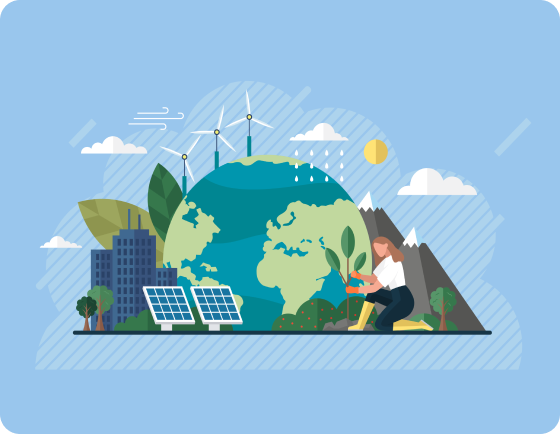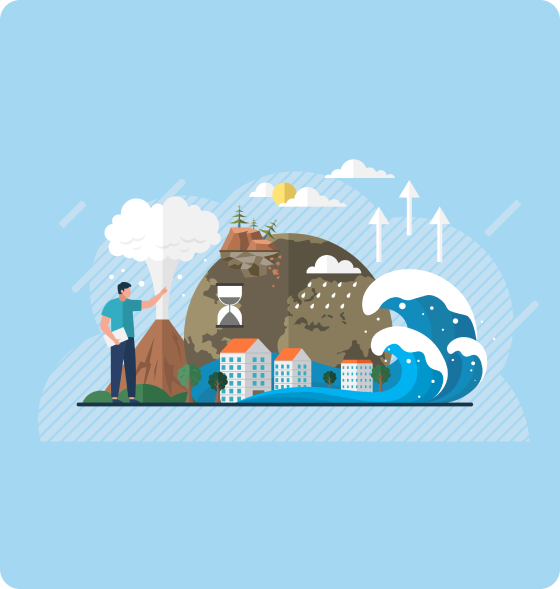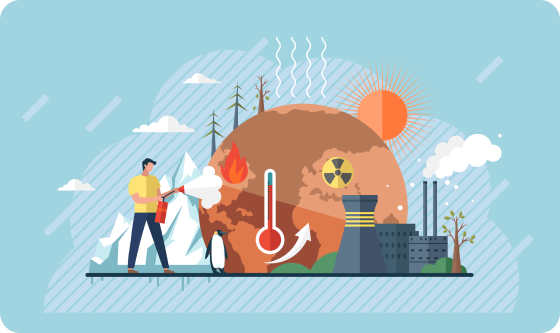Climate change
Firstly, what is climate? Climate is the average pattern of weather, over many years for a particular area such as the United Kingdom. Climate is not the same as weather, as weather is what you notice each day, such as wind, rain or sun.
What is climate change?
There’s a lot of talk about climate change but it’s not always clear what it means and how it affects us. Since the 1900s, scientists have seen changes in climate that are mainly caused by human activities and behaviour, rather than natural changes.
Have you heard of the “greenhouse effect”? Just like a greenhouse traps heat to create a warm home for plants, the Earth’s atmosphere functions in a similar way, on a larger scale, keeping some of the warmth from the sun. Without this natural greenhouse effect, the earth would not be able to support many of the animals and plants we see today. When we burn fossil fuels, gases are released into the atmosphere, leading to a greater warming of the planet. This disruption to the climate contributes to global warming.

Why is climate change a problem?
When the Earth gets too warm, it harms the plants and animals we need for food and other resources. It changes weather patterns, which makes it harder to grow crops. Melting ice caps make the oceans rise, flooding some areas. Warmer seas absorb even more heat, creating a cycle of damage. Entire ecosystems are affected, and some species may not survive.
Carbon dioxide, one of the main greenhouse gases can stay in the atmosphere for up to 1000 years! Think of the Earth’s atmosphere like a bathtub filling with water. If we continue to pour water (carbon dioxide), it will eventually overflow. To fix this, we need to do two things: slow down the inflow by producing less emissions (turning off the tap) and find ways to remove the carbon dioxide already present in the air (pulling the plug). This is the idea behind “Net Zero”.

Where do greenhouse gasses come from?
The main sources of greenhouse gases are:
-
Energy – Burning fuels to heat homes, power factories, or run cars and planes.
-
Farming – Especially raising animals like cows and growing rice, which release methane, another greenhouse gas.
-
Industry – Making too many products we don’t need, which creates waste.
-
Destroying Nature – Cutting down trees and destroying wetlands, which would normally soak up carbon dioxide.
When people talk about climate change, they usually focus on these emissions, but pollution and environmental damage also play a big role. For example, cutting down forests, spilling oil, dumping chemicals, and overfishing all harm the planet's natural systems.
How did this happen?
The way we live today—using lots of machines, cars, and factories—started around 1760 with the Industrial Revolution. This was when people began using coal and other fuels to power machines, build cities, and trade more goods. It made life easier in many ways, but it also began releasing large amounts of greenhouse gases.
Do we need to worry?
Scientists think that climate change will affect a lot of our world. Scientists and leaders believe that climate change is a very big problem, even bigger than any other problem humans have faced recently.
Why we need to act quickly
If we don't start fixing the problem soon, the climate could become much more unpredictable. This means it could get harder to grow enough food for everyone, especially in poorer countries where people are already struggling.
The impact on nature
Some types of animals and plants might even disappear forever.
Who is most affected?
Climate change hurts everyone, but some people suffer more than others. Often, the people least responsible for the problem are hit the hardest. For example:
- people in areas with high air pollution, like busy roads, may have worse health problems
- coastal villages face flooding as sea levels rise
- in some countries, like Nigeria, oil spills ruin rivers that people depend on for drinking water and fishing
Around the world, poorer communities and individuals from diverse backgrounds are often the most affected by environmental issues. Richer nations, which have contributed the majority of emissions, must take greater responsibility for addressing the problem.
Can we stop climate change?
Most climate experts think we need to act quickly to reduce the amount of greenhouse gases that humans are releasing into the atmosphere. We will probably be unable to stop the effects of climate change completely, but we might be able to limit them. To do this we all need to think about the energy we use in our everyday lives and try to use less.
If everyone does something to reduce the amount of energy we use, we can limit the effects of climate change. Is there something that you or your family could do to help make a difference?

What can we do?
Even though the problem is big, we can fix it if we work together. Changing how we live can not only protect the environment but also make life better for everyone. For example, tackling climate change can:
- improve health by reducing pollution
- create fairer opportunities for people everywhere
- help us rethink problems like racism, poverty, and unfair politics
We’re working hard to:
- create pollution free streets by your schools in Lewisham
- remove school heating systems that use fossil fuels, using heat pumps instead
- create flood defences, nature gardens and beehives in our schools
People all over the world are already finding solutions and imagining a future without fossil fuels. By working together, we can create a cleaner, healthier, and more hopeful world for everyone.
Case studies for climate action
-
Energy
Using fuels from other countries can make energy prices go up and down. For example, when the UK needed gas from Russia, the prices went up a lot during the war in Ukraine. At the same time, energy companies made very high profits.
South London Community Energy (SELCE) have new initiatives to make energy. They put solar panels on buildings like schools so they can make their own clean energy from sunlight.
Glossary: Solar PV means special 'Photovoltaic' panels that turn sunlight into electricity.
-
Fuel Poverty
Making homes warmer and using less energy can help families who struggle to pay their bills. In Lewisham, the Council are working to make 1,000 homes more energy-efficient. They are using solar panels and heat pumps instead of gas boilers. They’ve raised £3.5 million to make homes better for families. In 2024, SELCE helped 1,381 vulnerable people save money by using less energy at home.
Glossary: Retrofitting means making old homes better at keeping heat in and using cleaner energy.
-
Waste
Lewisham Council doesn’t send waste to landfills but burns it instead, which still pollutes the air. The borough produces enough rubbish each day to fill 22,000 football pitches! This works out to about 42kg per person every year. Buying and throwing away less can help save money and stop pollution.
Our leftovers from food bins are now collected and turned into energy and fertiliser for growing more food with.
-
Overproduction
Fixing and reusing items is better for the environment than throwing them away or recycling. You can visit Make Mee Studios for free sewing and repair classes. Donation Hub and Catbytes fix old electronics. We also have 17 new recycling banks for clothes and electronics in Lewisham, where you can put your old things.
Did you know? 150 billion items of clothing are made every year, but 40% are never worn. Buying secondhand clothes is a great way to help the planet and reduce waste.
-
Air quality
Breathing dirty air from cars can make people sick. In the UK, about 40,000 deaths every year are caused by air pollution.
It’s a good idea to walk, cycle, and scoot to school instead of driving.
Lewisham now has 50 School Streets where cars are not allowed, to make it safer and healthier for us to walk or cycle to school.
-
Biodiversity Loss
Humans have destroyed about half of the trees on Earth, but in Lewisham, we are planting and protecting trees. The borough has 33,052 trees, which help clean the air and absorb carbon. These trees take in enough carbon to power all the streetlights in Lewisham.
School children in Lewisham are also helping by creating tiny forests in our parks, like in Ladywell, to help nature and give people green spaces.
-
Ocean acidification
Oceans are becoming more acidic because they absorb too much carbon dioxide. This harms coral reefs, which are home to 25% of sea life. If we don’t act, 60% of reefs could disappear in the next 20 years.
The Horniman Aquarium in Lewisham is helping coral reefs. They were the first in the world to make coral reproduce in a lab, which could help save reefs in the future.
-
Heat
Cities can get much hotter than the countryside because of roads and buildings that trap heat. The more trees we plant, and all our community gardens means the Lewisham is getting more shade and cooler air.
-
Flooding
Lewisham could flood because it is near the River Thames. The borough had a big flood in 1968. People are working hard to build better drainage in schools, parks, and walkways to protect Lewisham from floods.
-
Education
Learning about climate change can be hard, but projects like Retrofit Action for Tomorrow (RAFT) are helping. They are teaching schools to use cleaner energy and helping children learn how to take action to protect the planet.